Chronus Exhibition:
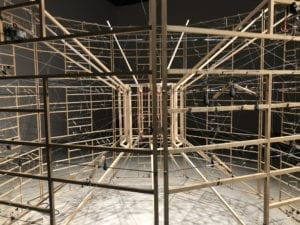
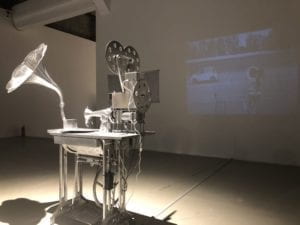
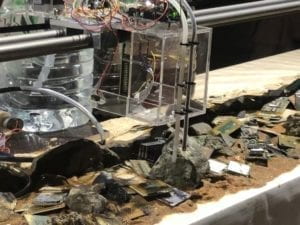
The visit to Chronus Exhibition was very interesting and inspiring. I saw many great and interesting art pieces that are technology-based, which highly related to our course. There are many art pieces using the same components that we used during the class such as Arduino boards and servo motors. Among them, the most attractive one to me is Arthur Ganson’s art piece called Beholding the Big Bang made by motors, gears, and concrete block. By using a motor to drive a series of gears, each gear is rotating in different speeds. The farther distance the gears get from the motor, the slower speed they attain. Finally, the time for the last gear to rotate once is 13.82 billion years. However, this last gear is deeply embedded in a concrete block. Even though it seems like the last one is static, it still rotates in an extremely slow speed that our eyes cannot capture. This art piece presents the passing of time and mimics what time can change by using electricity and technology in an obvious and direct way. Although we cannot witness the damage of the concrete block now and probably also in a long time, the motor that drives those gears are continuously working and it will break the concrete block, eventually. We cannot see the future, but we can still see what’s affecting the future. This art piece enlightens me that the forms of art are too many and too varied. Use your imagination boldly and you can create something astonishing as well.
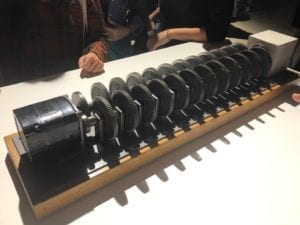
Nevertheless, except Beholding the Big Bang, other art pieces are too intricate and elusive to me. Even though I read the introductions carefully, I still cannot understand the producers’ intentions of these pieces. Compared with Chronus Exhibition, other exhibitions of non-technology based art work are more straightforward and easy-to-understand. I accidentally ran into an exhibition of paintings after I came out from Chronus Exhibition. The painter of these paintings is an old man in his eighties. What he drew is all kinds of colorful flowers that make his audience feel settled and comfortable. Different from Chronus Exhibition, there is no introduction for any painting in the gallery. People can easily understand what the painter tries to convey through his paintings. In addition to beautiful flowers and various bright colors, I can also feel the vitality of not only the flowers but also the painter. From the comparison of Chronus Exhibition and the painting exhibition, I’m aware that different forms of art takes different mindsets and ways of thinking to understand. For technology-based exhibitions like Chronus Exhibition, audiences should obtain some relative knowledge in advance and take a close look at all the components of pieces, how they function, and the relationship between each part in order to grasp a comprehensive understanding of the piece. But for other non-technology based exhibitions, they are more emotionally communicating with their audiences, for most of the times audience don’t need to have any background information before visiting these exhibitions.

Research:
Hertzian Landscapes – Richard Vijgen
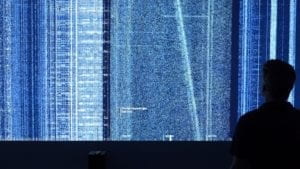
By using a digital receiver to scan the real time radio spectrum and certain algorithms to produce images, this project presents a live visualization of the invisible radio spectrum. As the audiences move around Hertzian Landscape, the digital receiver can capture the movements and the real time radio spectrum corresponding to them. Then, it becomes quite obvious for the audiences to see how the radio spectrum is changing when the audiences are moving. The audiences can make sense of how to interact with the piece quickly by observing how the image on the screen changes according to their movements, which seems like a successful interactive experience to me. By moving their bodies, the audiences can capture the changes of radio spectrum visually. There’s no need for the producer to provide long and tedious introduction to show his audiences what to do. The interaction between the piece and its audiences is very clear and straightforward.
TAMI – Francisco Zamorano and Catalina Cortes
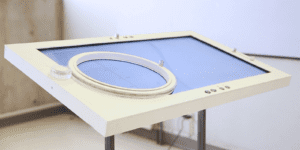
This piece is a learning tool of trigonometry comprised of a tabletop display and a series of physical controllers. Since many students always find it hard to learn trigonometry, this project focuses on this need and presents a clear and interactive way to learn trigonometry. By rotating the knob, the audiences can see a clear image illustrating trigonometry on the display. By pressing different buttons at the edge of the display, different information about trigonometry would show up. This piece is not only interesting but also very useful. Bringing this piece to a calculus class, students can easily comprehend trigonometry by experiencing and witnessing the changing data on the display. The interactive experience is simple and straightforward as well. TAMI presents all the contents that it wants to show to its audiences in a very clear way. By interacting with it, the audiences can gain the experience of learning while playing.
Self-Choreographing Network – Mathias Maierhofer and Valentina Soana
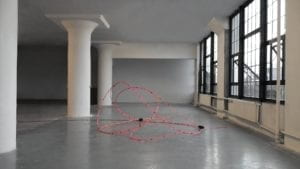
This piece is made of bending rods and robotic joints. However, this is a less successful interaction project to me. On the one hand, the approach of interaction is not obvious enough. The only thing I observe from the interaction between this piece and its audiences is that it moves with the audiences’ movements. Yet what patterns of its movements and what movements it can present is vague to me. On the other hand, I cannot easily understand what the producers want to convey through this piece. It’s hard for the audiences to comprehend what this piece is about and what the interaction means through their experience of interacting with it. This piece is not clear and direct enough for its audiences to get the idea of the producers.
Reflection:
During the group project, the definition of interaction that we came up with is that “interaction is a continuous conversation between two or more corresponding elements”. So in the midterm project, my partner and I put our focus on the “continuous conversation” between the users and piece. However, we neglected a key point that the interactive experience is also important to the interaction. Our project didn’t pay too much attention to the experience, so it may not be clear enough for some users about how to interact with the piece. Learning from this experience, I think a successful interactive experience should be that users can easily and continuously interact with the piece and the piece can provide interesting and/or meaningful output to the users constantly. The interaction itself should also be straightforward to the users and continuous which means that the output should vary corresponding to the changing of users’ input. This also aligns with the definition that Chris Crawford gives, “interaction is a cyclic process in which two actors alternately listen, think, and speak”. For “listen, think, and speak”, O’sullivan and Igoe gives an explanation that they are equivalent to “input, processing, and output in computer terms”. These two authors both demonstrate that one of the key factors of interaction is continuity, which I paid great attention to in both group project and midterm project. Another key point that I identify in the project TAMI is that the interactive experience is essential as well. On the one hand, the approach of input should be clear and straightforward to every user. On the other hand, the output should be interesting and/or meaningful that varies corresponding to users’ different input. In that case, we should design multiple output instead of using only one. In the future, I will take the key elements that I just mentioned into my final project.
References:
Hertzian Landscapes – The interactive space of a radio spectrum
TAMI – An intuitive approach to the learning of trigonometry
Self-Choreographing Network – Cyber-physical design and interactive bending-active systems
The Art of Interactive Design by Crawford (pages 1 – 5).
Physical Computing – Introduction by O’sullivan and Igoe.